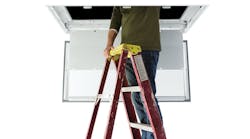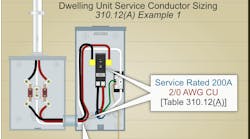You can use the grounded circuit conductor to ground (bond) the non-current carrying parts of equipment (and raceways and other enclosures) at certain locations [see NEC Sec. 250.142]. In many (but not all) wiring systems, this would be the neutral conductor.
On the supply side, the grounding point must be within the enclosure of the:
- AC service-disconnecting means, or
- Main disconnecting means for separate buildings as provided in Sec. 250.32(B), or
- Main disconnecting means or overcurrent devices of a separately derived system where permitted by Sec. 250.30(A)(1).
On the load side, you generally can’t use the grounded circuit conductor for this purpose. But it is permitted through an Exception to Sec. 250.32(B). Section 250.32 pertains to structures supplied by feeders or branch circuits.
Also, the frames of ranges can be grounded this way. However, “can be” and “should be” are not the same thing. Where practical (e.g., you can use or enlarge the existing holes), use a range cable containing a ground wire. Why? Because by definition [Art. 100] the neutral carries current, but the equipment grounding conductor brings potential (and thus current) to zero.



